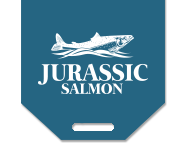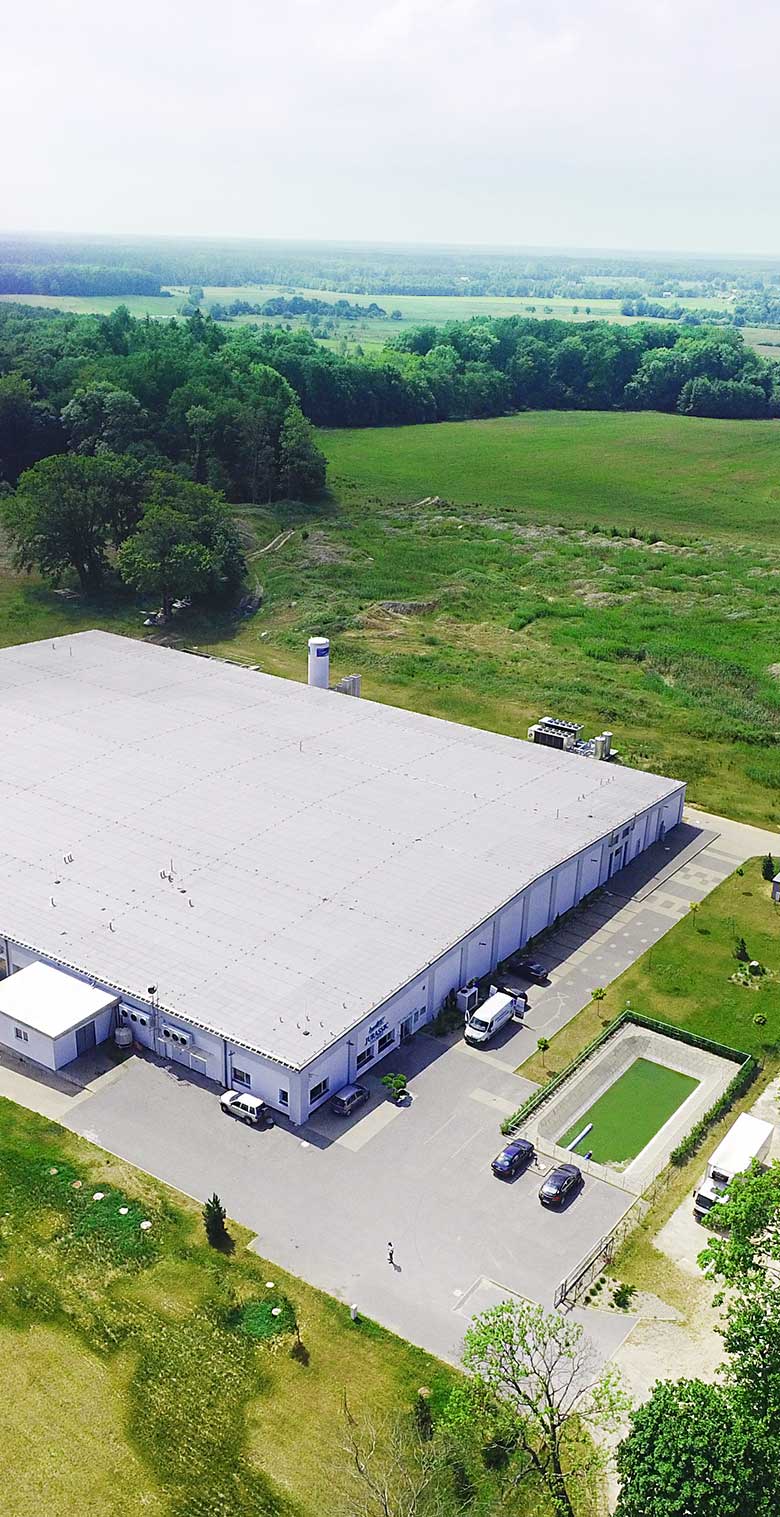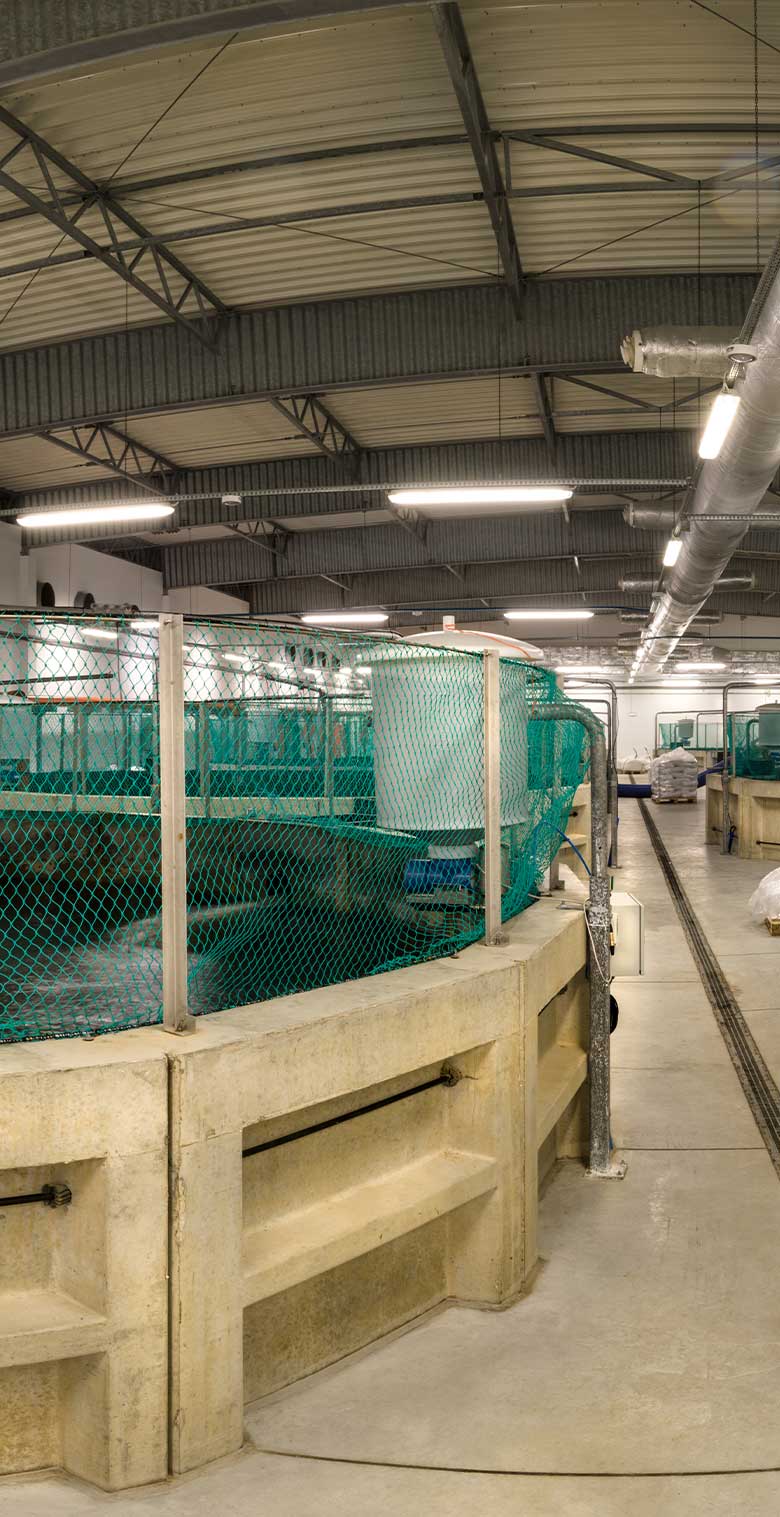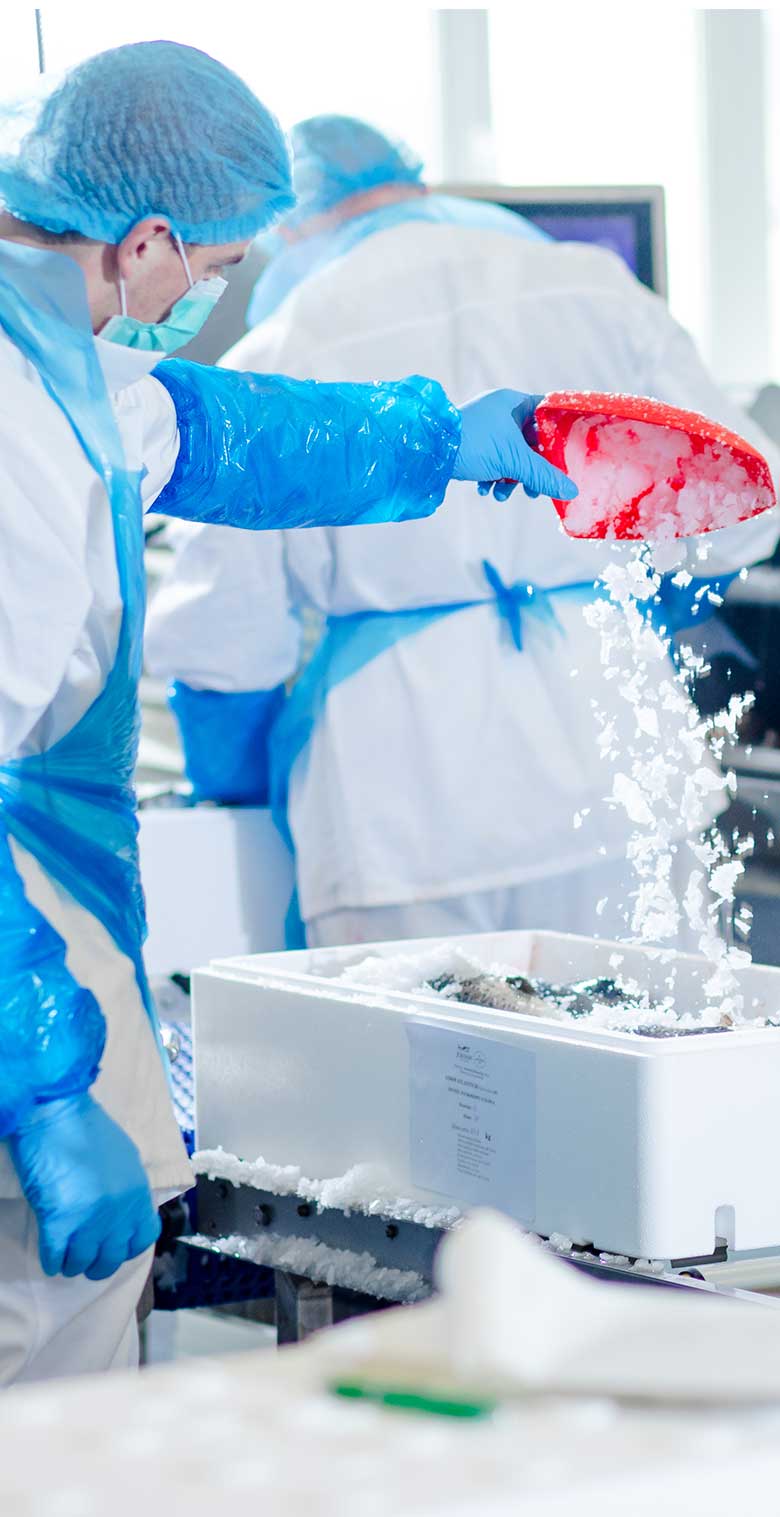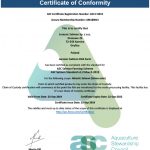

JURASSIC SALMON SPÓŁKA Z O. O.
J urassic Salmon Sp. z o.o. was estabilished on May 2013. Company profile is farming of Atlantic salmon in recirculating aquaculture systems, placed in modern facility with an area of 0.9 hectares. Fish farming in closed systems fully corresponds to the ideas of sustainable development and responsible production, allows to minimize the negative impact on the environment and assures the optimum condition and welfare of the fish. It is a specific response to the constantly growing demand for fish and fish products, along with process of shrinking natural resources of fish in the seas and oceans.
Jurassic Salmon facility is the most modern and technologically advanced RAS Atlantic salmon (Salmo salar) farm situated in Janowo, West Pomerania, Poland. It is also the world’s first plant which is using geothermal saline waters for this purpose and the third such farm leading production from egg to harvest size. This is also the largest farm of such a type in Europe, and is located below the Jutland Peninsula, Denmark.
The Jurassic Salmon company, in collaboration with the scientific environment of the West Pomeranian University of Technology in Szczecin, under the direction of Prof. Jacek Sadowski has started the research project entitled “The use of saline geothermal water for fish hatching and ongrowing”. The joint action of Jurassic Salmon Sp. z o.o. and the scientific environment in the construction of RAS salmon farm, as well as research methodology and results obtained from the analysis of farm operation, will undoubtedly contribute towards the development of intensive aquaculture, both in Polish and European conditions.
Within the framework of the operational programme “Sustainable development of fishery and riparian fishing areas 20072013”, action 3.5 Pilot project was cofinanced from public funds at the amount of 25,092.132 PLN.


What makes fish from Jurassic Salmon special?
J urassic Salmon is the only farm in the world, in which salmon grows on extremely pure and microbiologically safe geothermal water from the Lower Jurassic period, which comes from a 1224,5 meters deep borehole.
Geothermal water is 150 milion years old and contains a set of micro and macroelements, which presence has a positive effect on fish health and condition as well as meat quality.
Water is not contaminated with heavy metals, dioxines, WWA or toxic substances which come from industry or agriculture, and can accumulate in meat of salmon from Chile or Norway.

HEALTHY SALMON FROM POLAND
We respect the environment
During production process antibiotics or carcinogenic and toxic substances like. formalin or pesticides are not in use.
Fish are fed with feed based on fish meal, with natural colour – panaferd, without the addition of GMO or terrestrial animal protein.
Slaughter is performed in the same building – it takes only few minutes to pump the fish from the ongrowing to processing room, which allows to reduce stress level to minimum. It has positive effect on meat quality (no discolorations, blood marks, bruises, gaping) and weight losses.
Quick deliveries to processing plants in Poland and Germany allows to process salmon in pre-rigor state – before rigor mortis occur.
Salmon culture in Jurassic Salmon is based on ASC standards, and slaughter procedures are performed in accordance to BRC and IFS standards.
Fish deliveries are performed on a regular basis in the amount of 22 tons per week.

Hatchery
20%Participation in the full cycle
The eggs of Atlantic salmon Salmo salar are incubated in hatcheries. The eggs are imported from producers in Norway and Iceland regardless of the season. Each time a batch containing from 80,000 to 120,000 eggs is imported. The basic production stages are as follows: system disinfection, egg placement in trays, incubation, egg capsule removal, alevin (larvae) rearing until yolk sac depletion of 95%.
Eggs are incubated in 14 trays with artificial grass placed in 2 polycarbonate channels. The system has no biofilter and water cleaning is based mainly on microfiltration and UV sterilization. Despite the low temperature in the hatchery, the nitrification process occurs to a limited extent due to the activity of bacteria forming a biofilm in channels.System capacity: 1,1 m3
The retention time for a single batch: 10-12 weeks until 880 degree days
The weight reached at the end of this stage: approx. 0.2 grams
Start Feeding
40%Participation in the full cycle
At this stage, avenil of an average weight of 0.2 grams is placed in 3 tanks where they learn to swim in midwater and to eat the feed. At the beginning of the first feeding the feed granulation is 0.3 mm and is gradually increased up to 1.0 mm along ith fish growth. During the first 4 weeks, feed is fed in excessive amounts, ad libitum (without restriction), so that every fish can grab feed. The flow velocity is gradually increased and water circulation is clockwise. This corresponds to surface water flow in the environment at latitudes of the northern hemisphere.
Water purification and treatment is based mainly on microfiltration, nitrification occurring in two biofilter sections and UV sterilization. During water treatment, carbon dioxide is removed, while oxygen is added (saturated with oxygen). The biofilter with a capacity of 6m3 is capable of withstanding a feed rate of up to 12 kg per day.System capacity: 16 m3
The retention time for a single batch: 8-10 weeks
The weight reached at the end of this stage: from 2.5 to 4.0 grams
Fry Smolt
60%Participation in the full cycle
At the initial stage, avenil with an average weight of 2.5 to 4.0 grams is transferred to 10 tanks each with a capacity of 3.3 m3 . After reaching 20-30 grams, the fish are distributed into 9 large tanks with a capacity of 16.5 m3. During the initial period of growth fry feeds of a granulation of 1.0, 1.5 and 1.8 mm are still used. After being transferred into larger tanks, a grower feed with diameters of 2.0 and 2,5 mm is gradually introduced. At this stage the water current should be set so that a velocity of 1.5 x fish length per second is achieved. A fish swimming up-stream burns off tissue fat, while developing muscles, thus gaining a significant increase in body weight.
The biofilter consists of the three independent sections and has a capacity of about 100 m3 and withstands a feed load of 200 kg per day. Microbiological safety is assured by the three sets of 8 UV lamps, which work continuously. The temperature is adjusted by using a heat pump system.System capacity: 288 m3
The retention time for a single batch: 11-16 weeks
The weight reached at the end of this stage: from 50 to 80 grams
Post Smolt
70%Participation in the full cycle
At this stage the fish undergo the smoltification process that includes a number of physicochemical and physiological changes enabling salmon to adapt to living in salt water. The fish of 50-80 grams in weight are placed in 6 tanks, each of a capacity of 40.5 m3. The onset of winter is simulated by decreasing the temperature by a few degrees and lowering the intensity of the light. Simultaneously, the salinity is increased by supplying the system with geothermal water. The tanks are 2.5 m deep and of 5 metres in diameter. The fish are fed on a feed of 2,5 and 3,0 mm in granulation.
The biofilter consists of the three independent sections and has a capacity of 160 m3.It withstands a feed load of up to 300 kg per day. The temperature is adjusted by using a heat pump system. Microbiological safety is assured by 4 UV lamps. The tanks are supplied with treated water by using gravity, without pumps.System capacity: 402 m3
The retention time for a single batch: 5-7 weeks
The weight reached at the end of this stage: from 100 to 150 grams
On-growing
100%Participation in the full cycle
The on-growing facility is the final stage of salmon farming when the fish grow from 100 grams up to an average weight of 5 kg. To achieve this goal 14 concrete tanks are used. The largest of them have a diameter of 15 metres, a depth of 6 m and a capacity of 850m3. 4 tanks are for fish conditioning only, not for production purposes. The salinity of water used in on-growing is 16-18‰. The fish are fed on a feed of 3.0, 4.0, 6.0, 8.0 and 10 mm in granulation. The total system capacity is about 6600 m3. The fish are transferred into the on-growing tanks by using high capacity pumps.
The biofilter of 1300 m2 in surface area consists of 3 large microscreens, fixed and moving bed filters, and 2 hood filter sections. Microbiological safety is assured by eight UV lamps. The temperature is adjusted by using a heat pump system. The tanks are supplied with treated water by using gravity, without pumps.
System capacity: 6600 m3
The retention time for a single batch: 24-32 weeks
The weight reached at the end of this stage: 5000 grams
Organic salmon farming in Janów
See the only farm in the world that uses geothermal water from 150 million years ago.
